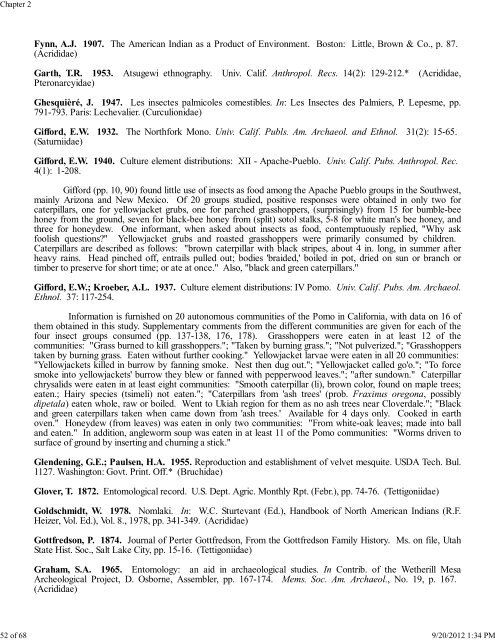Chapter 2. Insect Foods of North American Indigenous Populations ...
Chapter 2. Insect Foods of North American Indigenous Populations ...
Chapter 2. Insect Foods of North American Indigenous Populations ...
You also want an ePaper? Increase the reach of your titles
YUMPU automatically turns print PDFs into web optimized ePapers that Google loves.
<strong>Chapter</strong> 252 <strong>of</strong> 68 9/20/2012 1:34 PMFynn, A.J. 1907. The <strong>American</strong> Indian as a Product <strong>of</strong> Environment. Boston: Little, Brown & Co., p. 87.(Acrididae)Garth, T.R. 1953. Atsugewi ethnography. Univ. Calif. Anthropol. Recs. 14(2): 129-21<strong>2.</strong>* (Acrididae,Pteronarcyidae)Ghesquièré, J. 1947. Les insectes palmicoles comestibles. In: Les <strong>Insect</strong>es des Palmiers, P. Lepesme, pp.791-793. Paris: Lechevalier. (Curculionidae)Gifford, E.W. 193<strong>2.</strong> The <strong>North</strong>fork Mono. Univ. Calif. Publs. Am. Archaeol. and Ethnol. 31(2): 15-65.(Saturniidae)Gifford, E.W. 1940. Culture element distributions: XII - Apache-Pueblo. Univ. Calif. Pubs. Anthropol. Rec.4(1): 1-208.Gifford (pp. 10, 90) found little use <strong>of</strong> insects as food among the Apache Pueblo groups in the Southwest,mainly Arizona and New Mexico. Of 20 groups studied, positive responses were obtained in only two forcaterpillars, one for yellowjacket grubs, one for parched grasshoppers, (surprisingly) from 15 for bumble-beehoney from the ground, seven for black-bee honey from (split) sotol stalks, 5-8 for white man's bee honey, andthree for honeydew. One informant, when asked about insects as food, contemptuously replied, "Why askfoolish questions?" Yellowjacket grubs and roasted grasshoppers were primarily consumed by children.Caterpillars are described as follows: "brown caterpillar with black stripes, about 4 in. long, in summer afterheavy rains. Head pinched <strong>of</strong>f, entrails pulled out; bodies 'braided,' boiled in pot, dried on sun or branch ortimber to preserve for short time; or ate at once." Also, "black and green caterpillars."Gifford, E.W.; Kroeber, A.L. 1937. Culture element distributions: IV Pomo. Univ. Calif. Pubs. Am. Archaeol.Ethnol. 37: 117-254.Information is furnished on 20 autonomous communities <strong>of</strong> the Pomo in California, with data on 16 <strong>of</strong>them obtained in this study. Supplementary comments from the different communities are given for each <strong>of</strong> thefour insect groups consumed (pp. 137-138, 176, 178). Grasshoppers were eaten in at least 12 <strong>of</strong> thecommunities: "Grass burned to kill grasshoppers."; "Taken by burning grass."; "Not pulverized."; "Grasshopperstaken by burning grass. Eaten without further cooking." Yellowjacket larvae were eaten in all 20 communities:"Yellowjackets killed in burrow by fanning smoke. Nest then dug out."; "Yellowjacket called go'o."; "To forcesmoke into yellowjackets' burrow they blew or fanned with pepperwood leaves."; "after sundown." Caterpillarchrysalids were eaten in at least eight communities: "Smooth caterpillar (li), brown color, found on maple trees;eaten.; Hairy species (tsimeli) not eaten."; "Caterpillars from 'ash trees' (prob. Fraxinus oregona, possiblydipetala) eaten whole, raw or boiled. Went to Ukiah region for them as no ash trees near Cloverdale."; "Blackand green caterpillars taken when came down from 'ash trees.' Available for 4 days only. Cooked in earthoven." Honeydew (from leaves) was eaten in only two communities: "From white-oak leaves; made into balland eaten." In addition, angleworm soup was eaten in at least 11 <strong>of</strong> the Pomo communities: "Worms driven tosurface <strong>of</strong> ground by inserting and churning a stick."Glendening, G.E.; Paulsen, H.A. 1955. Reproduction and establishment <strong>of</strong> velvet mesquite. USDA Tech. Bul.1127. Washington: Govt. Print. Off.* (Bruchidae)Glover, T. 187<strong>2.</strong> Entomological record. U.S. Dept. Agric. Monthly Rpt. (Febr.), pp. 74-76. (Tettigoniidae)Goldschmidt, W. 1978. Nomlaki. In: W.C. Sturtevant (Ed.), Handbook <strong>of</strong> <strong>North</strong> <strong>American</strong> Indians (R.F.Heizer, Vol. Ed.), Vol. 8., 1978, pp. 341-349. (Acrididae)Gottfredson, P. 1874. Journal <strong>of</strong> Perter Gottfredson, From the Gottfredson Family History. Ms. on file, UtahState Hist. Soc., Salt Lake City, pp. 15-16. (Tettigoniidae)Graham, S.A. 1965. Entomology: an aid in archaeological studies. In Contrib. <strong>of</strong> the Wetherill MesaArcheological Project, D. Osborne, Assembler, pp. 167-174. Mems. Soc. Am. Archaeol., No. 19, p. 167.(Acrididae)
















